Devil’s Canyon Review: Intel Core i7-4790K and i5-4690K
by Ian Cutress on July 11, 2014 10:00 AM EST- Posted in
- CPUs
- Intel
- Haswell
- i7
- Overclocking
- Devil's Canyon
- i5
- 4790K
- 4690K
Discrete GPU Gaming
When comparing CPUs to APUs, one strength shown by team Blue in the past is the discrete GPU performance. However even when using dual graphics cards at a 1920x1080p resolution, we seem to have hit a wall where extra CPU performance does not necessarily translate to more frames per second. Our results below show little difference between the Haswell processors, and we need to go down to a 2.0 GHz i7 or a 3.5 GHz i3 CPU to see a significant drop in frame rates. The biggest benefit from overclocking seems to be F1 2013 minimum frame rates.
F1 2013
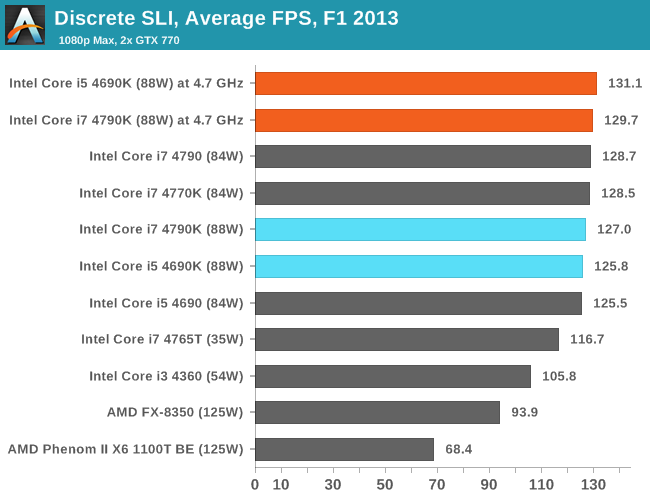

Bioshock Infinite

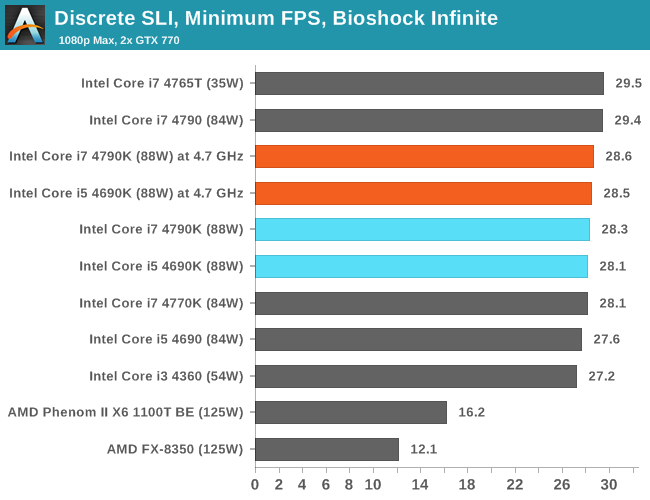
Tomb Raider
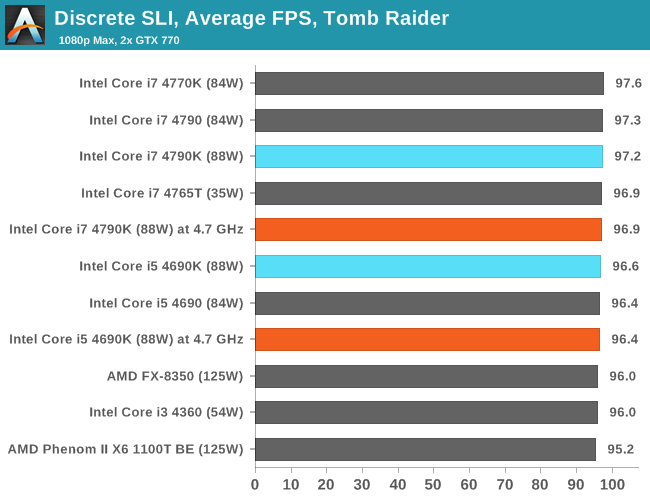
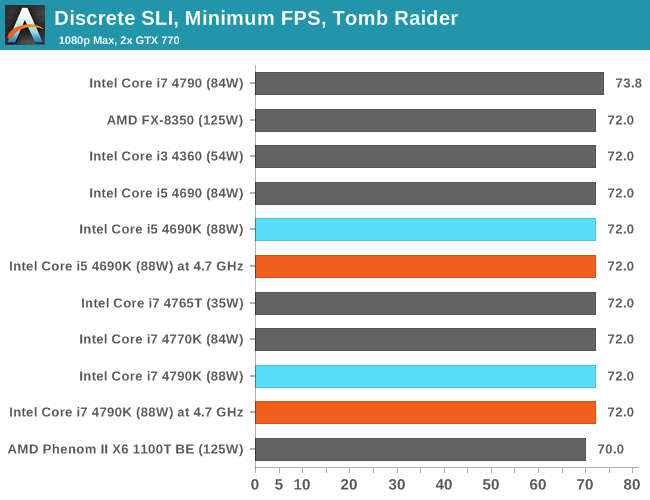
Sleeping Dogs
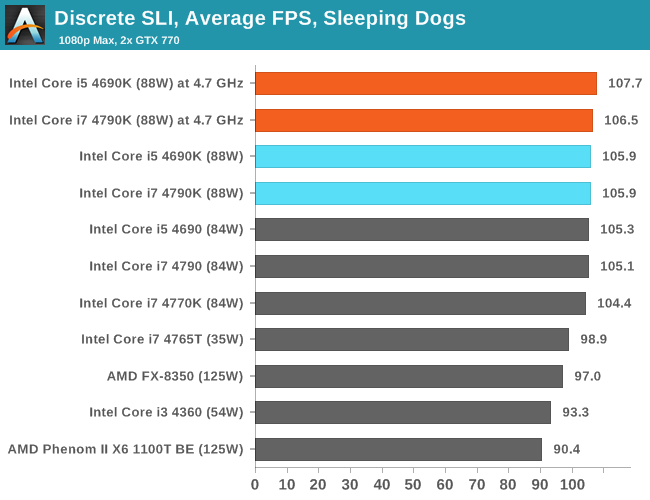
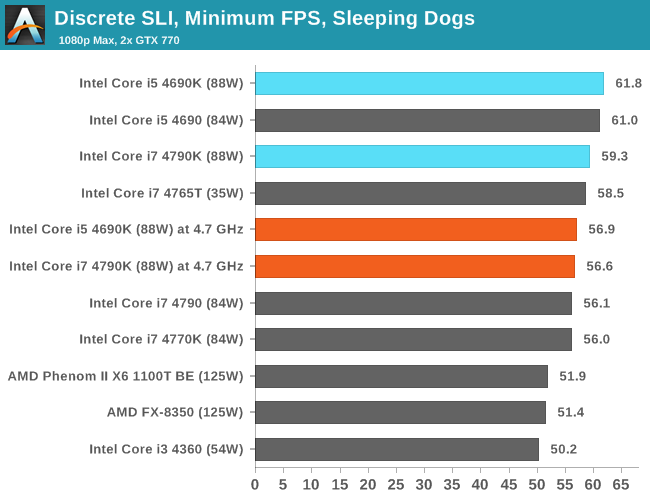
Company of Heroes 2
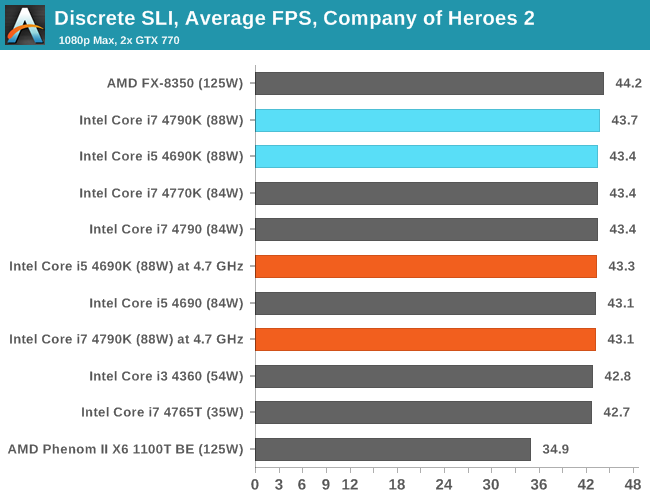

Battlefield 4

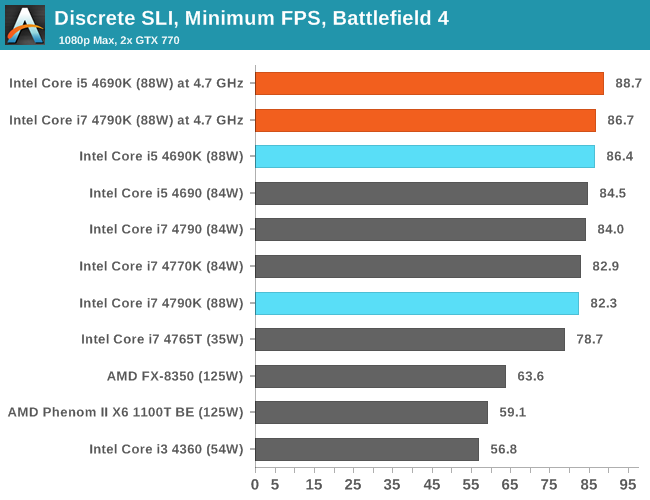










117 Comments
View All Comments
leoblaze9 - Friday, July 11, 2014 - link
WOW! what happened in the particle simulation test? that difference is STAGGERING!!just one of the prime examples of the benefits of using both cpu and gpu together as a cohesive whole rather than two discrete entities. I am genuinely amazed at AMD's engineering! kudos AMD....you deserved that one!
MamiyaOtaru - Saturday, July 12, 2014 - link
possible reason they don't use solder anymore: http://iweb.tms.org/PbF/JOM-0606-67.pdfspecifically:
"At higher thermal cycles the cracks have propagated across the entire center region of the die and significantly degrade thermal performance.This failure mechanism is predominant on small die form factors. The center degradation mode is not observed, as the die size is increased to the large and medium sizes"
Smaller die sizes are more likely to see cracks in the solder spread to the middle, significantly harming thermal performance. Ivy Bridge / Haswell with their process shrink have smaller die sizes, perhaps making solder unworkable as a TIM
ZeDestructor - Monday, July 14, 2014 - link
Interesting....Galatian - Saturday, July 12, 2014 - link
I agree: 4,6 GHz seems to be the sweet spot. Mine uses 1,25V core and a 0,175 V offset uncore to reach Ringbus parity. I needed 1,294V for 4,7 and 1,345 for 4,8. Temperatures were off the hook though and this is with a custom-liquid loop with 2 480mm radiators (one monsta and one 25mm) as well as Liquid Ultra. Stability tested with Prime95 24h and IBT 20 runs on maximum (kudos to IDK in the forum for is stability guide).It is an improvement as it seems to be easier to get a rock stable CPU, but temperatures still are a problem. The thing is: I don't believe a better solution would ultimately change anything. I mean when you clearly see that the sweet spot is 4,6 GHz with 1,25V one would assume that 5 GHz probably needs something like 1,5V and that's just dangerously high IMHO.
Also what I realized is that DC needs a lot less Input Voltage. Stock was at 1,8V, but even with my overclock I could dial it all the way down to 1,5V, which is amazing. Ian have you checked how low you can go? (I can't believe I just said that...). Also how exactly can Prime95 ruin a CPU? I still consider it gold standard, as it would show problems within minutes when other stress tests would happily run for hours. I know it is a hassle to let it run for 24h but nothing gets close to rock stable setting then Prime95.
pierrot - Saturday, July 12, 2014 - link
Now we just need the OC'd Anniversary Pentium benchmarks added in!andrew-1983 - Saturday, July 12, 2014 - link
The image is blurry, but the batch number of the 4790k lookslike L336... which if I'm decoding it right means 2013 36th week,
around 2013 September. Does that matter that you are testing
a 10 month old CPU for overclocking?
Galatian - Saturday, July 12, 2014 - link
That number stand for the time the silicon was started to be manufactures or something alike...(read the forums...it has been mentioned several times now)...there are a lot more step until a final chip is put together, so it really is not a 10 month old processor.andrew-1983 - Sunday, July 13, 2014 - link
Ok I get that, but when the retail cpu we buy has an L418C164 that's stillan 8-month difference, whatever the numbers actually mean, and there is
a new microarchitecture or die shrink in every year..
What I'm trying to say is overclockability should be tested with
silicon similar to what people will buy after reading the review.
bludragon - Saturday, July 12, 2014 - link
My chip need 1.237v to be prime95 stable at 4x4.4GHz. This is the stock vid for aturbo on 1 or 2 cores. Using an NH-D14 it would throttle on cores 2 and 3 (so hitting 105+deg?) withing a few minutes. Delidded it maxes at 91 degrees, so at least 15 degrees better and I used the Noctua TIM. I tried 4.6 but the voltage nneds to be 1.27 or higher as it throttled again there.ratbert1 - Saturday, July 12, 2014 - link
With an i5-2500k I still do not see the need to upgrade. I have run at 4Ghz with speedstep and voltage on auto for 3 years. My synthetics will be slower, but using an SSD my everyday usage is fine. Just ran Bioshock Infinite benchmark and got 115 fps average and 41 fps min. @1080p on GTX770 running stock speed(card is OC'd version though). Hopefully Broadwell early next year.